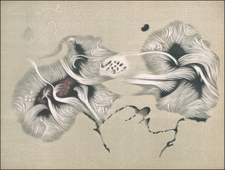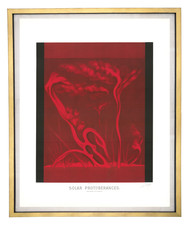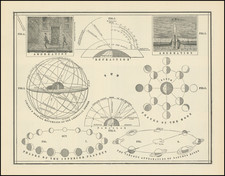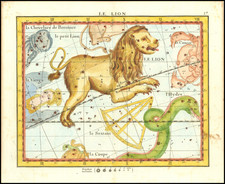Finely executed pair of Celestial Hemsipheres, published in London.
The stars are heightened in gold. The constellations of the hemispheres are finely engraved and colored.
John Flamsteed (1646-1719) was the first Astronomer Royal at the London Observatory, winning out over Edmund Halley and Isaac Newton. He made a copius and thorough study of the heavens, but refused to publish his works, despite the urgings of his colleagues, including Halley and Newton.
Flamsteed accurately calculated the solar eclipses of 1666 and 1668. He was responsible for several of the earliest recorded sightings of the planet Uranus, which he mistook for a star and catalogued as '34 Tauri'. The first of these was in December 1690, which remains the earliest known sighting of Uranus by an astronomer.
On August 16,1680, Flamsteed catalogued a star, 3 Cassiopeiae, that later astronomers were unable to corroborate. Three hundred years later, the American astronomical historian William Ashworth suggested that what Flamsteed may have seen was the most recent supernova in the galaxy's history, an event which would leave as its remnant the strongest radio source outside of the solar system, known in the third Cambridge (3C) catalogue as 3C 461, and commonly called Cassiopeia A by astronomers. Because the position of "3 Cassiopeiae" does not precisely match that of Cassiopeia A, and because the expansion wave associated with the explosion has been worked backward to the year 1667 and not 1680, some historians feel that all Flamsteed may have done was incorrectly note the position of a star already known.
In 1681, Flamsteed proposed that the two great comets observed in November and December of 1680 were not separate bodies, but rather a single comet travelling first towards the Sun and then away from it. Although Isaac Newton first disagreed with Flamsteed, he later came to agree with him and theorized that comets, like planets, moved around the sun in large, closed elliptical orbits. An angry Flamsteed later learned that Newton had gained access to Flamsteed's observations and data, with the aid of Edmund Halley.
As Astronomer Royal, Flamsteed spent some forty years observing and making meticulous records for his star catalogue, which would eventually triple the number of entries in Tycho Brahe's sky atlas. Unwilling to risk his reputation by releasing unverified data, he kept the incomplete records under seal at Greenwich. In 1712, Isaac Newton, then President of the Royal Society, and Edmund Halley, again obtained Flamsteed's data and published a pirated star catalogue. Flamsteed managed to gather three hundred of the four hundred printings and burned them. "If Sir I.N. would be sensible of it, I have done both him and Dr. Halley a great kindness," he wrote to his assistant Abraham Sharp.
In 1725 Flamsteed's Historia Coelestis Britannica was published posthumously, edited by his wife, Margaret. This contained Flamsteed's observations, and included a catalogue of 2,935 stars to much greater accuracy than any prior work. It was considered the first significant contribution of the Greenwich Observatory, and the numerical Flamsteed designations for stars that were added subsequently to a French edition, are still in use. In 1729, his wife published his Atlas Coelestis, assisted by Joseph Crosthwait and Abraham Sharp, who were responsible for the technical side.











![[ Crater ]](https://storage.googleapis.com/raremaps/img/small/70467.jpg)

![[ Triangulum ]](https://storage.googleapis.com/raremaps/img/small/88313.jpg)
